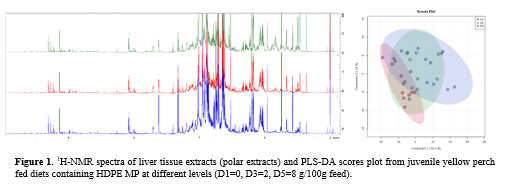EFFECTS OF POLYETHYLENE MICROPLASTIC-CONTAINING FEEDS ON THE METABOLITE PROFILES OF JUVENILE YELLOW PERCH Perca flavescens
Microplastics (MPs) are defined as plastic particles with a diameter <5 mm , which may derive from the fragmentation or degradation of larger pieces of plastic from manufactured products in the environment. In recent years, MPs have been recognized as a global threat to aquatic ecosystems causing widespread concern about their potential toxic effects. In fact, due to their small size and persistence in the environment, MPs can be ingested and accumulate in the tissues of a variety of aquatic organisms, including various species of fish . While several studies have reported MP ingestion by marine fish, less is known about MP ingestion and its effects on freshwater fish such as yellow perch (Perca flavescens), an important species in the Great Lakes.
A 9-week feeding trial was conducted in a flow-through aquaculture system to evaluate the effects of feeds containing high-density polyethylene (HDPE) MP s on the liver metabolite profiles of juvenile yellow perch, using a Nuclear Magnetic Resonance (NMR)-based metabolomic approach.
Feeds containing three different HDPE MP levels (0, 2, and 8 g/100 g feed) with particle size ranging from 120 to 125 μm , were tested . Three tanks of fish were randomly assigned to each diet at a stocking density of 15 fish/tank (average body weight, 25 g/fish). The fish were fed at a feeding rate of 2 % body weight daily. Liver samples were collected at the end of the feeding trial to evaluate possible differences in metabolite profiles among the dietary treatments (n=12/treatment). Polar extracts were analyzed by NMR spectroscopy and multivariate statistical analysis was applied to the processed NMR spectra (Fig. 1) . Significant differences in metabolite profiles were detected between fish fed the HDPE MP-containing feeds and the control diet , with more pronounced effects induced by the highest HDPE MP levels (8 g/100 g feed) compared with the low-level HDPE MP diet (2 g/100 g feed).
O ur study indicates that chronic ingestion of HDPE MP particles (size = 120-125 μm) through feeding induced alterations of hepatic metabolic profiles in juvenile yellow perch, and disturbed bile acid metabolism.
